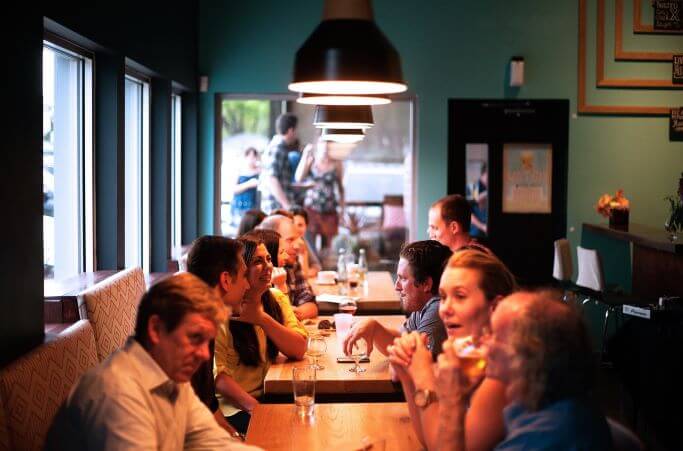
People have always loved dining out. They could be casually dining out with the family, nurturing a client over a business lunch or trying to impress someone over a date. Owning and running a restaurant is an entrepreneurial experience like none other. From maintaining a relevant menu to planning and executing marketing activities and managing employees, every day is a busy day for a restaurateur.
Things have gotten more interesting since the restaurant industry joined the “on-demand” bandwagon with the entry of the likes of Uber Eats and Seamless. Did you know that restaurants that won’t offer online ordering and delivery will lose more than 70% of their customers by 2020?
This article discusses everything you will ever need to know to run a restaurant successfully.
Target Markets
It is near impossible to find a restaurant with a universal appeal. This is why restaurant owners should get a deep understanding of who they’re serving. Many new restaurant owners often find it hard to accept that they’ll not capture 100% of the market because of this. The primary market categories for a restaurant are the following:
Choosing the Right Restaurant Concept
- Seniors are people aged 65+, and a majority of them may not be able to afford upscale restaurants often. They prefer family-style restaurants offering excellent service at reasonable prices. They also look for restaurants that provide early-bird specials and senior menus at lower prices.
- Empty nesters fall in the age group between the early 50s to mid-60s and have grown children who no longer live with them. They are not price conscious and typically go to upscale restaurants where they get excellent food and service. Empty nesters are drawn to elegant and sophisticated ambiance.
- Baby boomers are the largest segment in the United States. This segment also includes high-income professionals who can afford upscale restaurants. To attract and maintain baby boomers you have to (i) offer bigger and more robust flavours because taste and smell receptors often diminish with years (ii) adding a twist to the original dishes (iii) offering healthy items on the menu which are low-fat or fat-free, low-carb or cholesterol free. (iv) reward their loyalty
- Gen X is known for strong family values and are more likely to focus on their relationship with their children. They go for value and favor quick-service restaurants that offer all-you-can-eat items and buffets. Appeal to Gen X by providing a comfortable atmosphere of value and pleasant ambiance.
- Gen Y or the millennial generations are the most ethnically diverse, yet they are thrice as large as Gen X. they go for fast-food and quick-service items. 25% of restaurant visits by millennials are to burger franchises, followed by pizzas at 12%.
The concept of your restaurant will be the primary factor on which the location and cuisine will be decided. Some restaurateurs often make the mistake of choosing a concept without figuring out if it is the best choice considering the location, target customers and their budget. For example, it may not be a smart idea to open an Italian restaurant in a part of the city that is already cluttered with them. Choosing the right concept will lay the foundation for a restaurant to flourish. You should look at the following factors while choosing your restaurant’s concept.
- First things first, do proper market research to find out what[JV1] is the most ideal for your area. High competition may be favorable in a high-end food street, but it may be the opposite in a small town. Try to understand what works best in the market. If you are unsure about how to conduct market research, this article on designing a restaurant market research survey might help.
- Your budget is one of the main things you should consider while choosing your restaurant’s concept. You should have a budget that should be strictly adhered to. For example, don’t expect to set up a fine dining restaurant with the budget for a takeaway restaurant.
- The proposed location of the restaurant is pivotal in choosing the most effective concept. If the location is in a more “hipster” or student-centric neighborhood, it makes sense to open a fun and youth-oriented restaurant. A posh restaurant with basic colors and classy interiors will be perfect if you are in a corporate office area.
- Also, consider the size of the restaurant. If all you have is a space to accommodate a few tables, consider a casual takeaway concept. If your restaurant is large enough to accommodate bars and 20 tables, go for a popular concept with timeless dining options where people can dine in large groups. You can also remodel your restaurant.

Location!Location!Location!
Before applying for a loan or creating a business plan for your restaurant, you should first choose where the restaurant will be located. A restaurant’s location is fundamental to its success. You don’t want your restaurant to be located somewhere far away from people, or in a busy part of town with little or no parking space. If your restaurant is in the perfect location, you don’t have to spend as much money and time on marketing. There are certain factors that should be taken into consideration while choosing the ideal location for your restaurant.
- Restaurants should be somewhere that’s visible. Visibility can be determined by looking at foot traffic patterns. If most of the nearby pedestrians are not your target audience, that location may not be the one. Also, check how well the restaurant will stand out from the surrounding buildings and if they’d obstruct your restaurant’s visibility. The last thing you’d want is to have the most Instagram worthy restaurant in town hidden behind other buildings.
- Most of us have changed our minds about dining somewhere because there wasn’t a parking space available. Nobody wants to drive around the block looking for a place to park. What’s worse? They could end up choosing a competitor in the process. The site you want should be big enough to accommodate parking for your customers.
- The space should also meet your size requirements. The standard requirement is five square feet for every seat. A larger work space reduces accidents by minimizing slips, falls and trips.
- A patio could be a great way to increase your size as well as reaching a greater number of people. A study done by VSAG found that a $200k investment in a patio was expected to produce $500k in return. Patios offer more space for employees and customers to move as well as disability-friendly seating. It also allows your customers who don’t want to leave Fido at home to bring their pet along (given that your state allows it and you comply with local law).
- Crime rates in the neighborhood also influence the number of customers coming into the restaurant. It’s not a comforting feeling knowing that you might get mugged on the way from the restaurant to the parking lot.
- The cost of the space should be a reasonable one. For example, the rent you pay should not be more than what you are expecting to make in revenue each month otherwise, it could spell disaster.
Hiring People
Being a labor-intensive business, restaurants need people with different skill sets to work together; because not everyone can be a bartender or a waiter/waitress. Two main concerns of restaurant owners are lack of quality employees and rising labor costs. There clearly is a gap between “demand” and “supply”. Depending on the size of the restaurant and its concept, you should decide how many hosts, servers, dishwashers, cooks, and chefs are to be hired.

Finding the right people to hire is the most persistent problem in the restaurant business. There are sites like Poached and Culinary Agents that specialize in the restaurant industry. This will be a great portal to post job openings or to network with people and get a better view of what type of people to look for. Another way to get prospective employees’ attention is to post about job openings on your restaurant’s social media pages, such as; Facebook, Instagram and LinkedIn. The good thing about this approach is that people will share the post if they feel that it will help them or their peers. If all else fails, your best bet is to seek the help of an agency to find the best people to hire for you.
Once a pool of candidates is made, the next step is to choose the best ones. Ask situational questions during the interview process. For example, ‘You just spilled some gravy on your customer’s shirt, and he/she is yelling at you. What would you do?’ These questions may not have right or wrong answers, but they’ll give insights into the candidates’ thought processes and how they handle daily challenges at the restaurant.
The final and often most challenging task is making people stay-retaining talent. More than anything else, treating your employees well and showing gratitude can be good enough reasons for them to stay. This can be something as simple as an “employee of the week” program or a bonus for excellent customer service. You can check out this article on how to retain employees at your restaurant
Marketing Strategy
All your efforts as a business person will be for nothing if no one knows about your restaurant. A restaurant’s marketing strategy should be as good as the best food they have on their menu. The fact is that restaurants must compete for customers more than a retail store does is because, during unfavorable economic times, people may not have the budget to dine out. Although traditional means of marketing restaurants (Print, word of mouth, etc.) may still be effective, you may be better off investing your money and time on newer and better channels. Having a solid marketing strategy in place is essential. Keep the following in mind while developing a marketing strategy for your restaurant.
- Set an objective by assessing your businesses’ current business situation[JV1] . You can increase revenue by three ways; attracting new customers, increasing the average amount in marketing dollars spent per customer and encouraging customers to order more often. Once you choose one of these revenue tactics, a plan can be created keeping the objective in mind.
- The next step will require you to set SMART goals, which you’ll use to reach the restaurant’s overall objectives. The goal can be something like increase the customer base by 20% every six months or add/update a new signature dish every year. These goals will be used to determine the revenue the marketing plan is expected to bring in and your tracking will show your success or if changes need to be made.
- Before making any marketing plan decisions, you should know how much of your budget you have at your disposal for marketing. According to Restaurant Marketing Labs, to know how much you should be spending; multiply the desired revenue by 3 percent. If you have more money to shell out, you can go up to 6%. To support the latter option, it would be better to get a loan to market your restaurant.
- It helps to learn more about your customers. Start by asking questions that give you insights into how they feel before making the decision to come to your restaurant. Some questions could be like what do they feel before and after dining out? Are they stressed or calm? What would be something that you can do to improve their experience or what about their positive experience made it positive?
To make sure you are heard louder than your competitors, here are some proven marketing tactics that you can use for your restaurant:
- Social media challenges and contests Run
- Exclusive offers for social media fans
- Local SEO
- Ensuring your address is up-to date on search engines
- Ensuring you use local landmarks on your website
- Partner with an influencer
- Be a part of the local chamber of commerce
- Get to know leaders in the restaurant’s community
- Participate in a local non-profit event as a representative for the restaurant
- Have fun theme nights and/or have a weekly trivia night
- Build an engaging blog
- You can also ask for submissions from your customers
- Host a business meeting or offer a lunch discount to local businesses’ employees
Managing Finances
Owning a restaurant means there are multiple things on which you’ll be spending money. Over the initial capital needed to set up the business, money will be required to pay lease, purchase equipment, pay employees and to buy supplies. Business owners also need to consider the cost of signage and marketing to make sure that people know about the restaurant. There are multiple ways through which money can be raised. The most common method is to raise it from savings, borrowings from friends/family or borrowings from a 401(k) retirement plan.
Another popular option is to seek loans from banks and other commercial lenders. To qualify for this, you’ll need to show an excellent credit rating. They may require you to show them the collateral upon which the loan will be sanctioned. This can be real estate, a car or restaurant equipment. Moreover, you’ll have to convince the lenders that your restaurant will succeed. They would also want to know exactly how the money will be spent. Developing a business plan that demonstrates exactly how you’ll make enough money to repay the loan can make the approval process easier.
Once the restaurant is up and running, owners find themselves in a race to balance incomes with steep overhead costs and variable food costs. Managing cash flow is also a persistent problem for restaurants. And since the average profit margin for restaurants is 3.5 %, making the right decisions can make the difference between keeping the restaurant open or closing it down.
A budget can help keep track of the operations of the restaurant daily. Planning for times when business will be slow can save you money and frustration. A daily business review of the reports generated by most modern POS systems allows a thorough analysis of sales trends and customer counts. This will influence decisions from inventory management to the items on the menu.
Managing Food Delivery
Courtesy of the digital age, there are a growing number of people who prefer to have their favorite meal from their favorite restaurants sitting at their own homes. The growth of online food delivery services has been phenomenal. More and more restaurants are signing themselves up for this opportunity to take their business beyond their walls. Restaurants should carefully assess the delivery strategy that works best for them. The main parameters to consider while developing a food delivery plan are:
- So where and when do you sign up? New restaurants may feel like they are late to the party when they see larger competitors doing this already. While this may be true, any time is the right time to start. Be sure to keep in mind that this service is an industry that is still in its infancy. Success will be determined by flexibility and openness to new technologies.
- Should you hire an external delivery partner or have your own? An in-house fleet of delivery agents will give you complete command over your supply chain. But for restaurants that want to grow quickly, it is better to hire a delivery partner who will ask for a percentage cut from the order value. One downside is that customer loyalty will be in the hands of the delivery partner.
- Choosing the right delivery partner is not easy. You’ll have to go carefully through each contract. To ensure a good working relationship, find a delivery partner with a suitable pricing model, a large fleet and a good reputation.
Building a sustainable small business is not easy. Restaurant owners; both present and aspiring need to be clear about all the aspects of running a restaurant. From determining the right target market, to marketing, to managing food delivery- modern restaurants can only succeed once the right dots are connected together.






